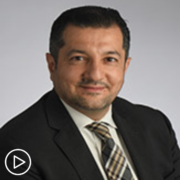Thriving With an MPN | Tips for Managing Worry and Anxiety
Thriving With an MPN | Tips for Managing Worry and Anxiety from Patient Empowerment Network on Vimeo.
Dr. Joseph Scandura explains the role of shared decision-making when deciding on an MPN treatment, and why it’s so important for patients to take an active role in their care.
Dr. Joseph Scandura is an Associate Professor of Medicine and Scientific Director of the Silver MPN Center at Weill Cornell Medicine. Learn more about Dr. Scandura.
Related Programs:

|

|

|
Transcript:
Katherine Banwell:
Can you talk about shared decision-making? Why is it so important for patients to work closely with their healthcare team on choosing a therapy?
Dr. Scandura:
Because these are therapies that last for a long time. And, hopefully, the patients and the relationship last for a long time. And so, I think that everybody has to be comfortable with the decision about a therapy. And my personal goal is to try to make sure that everybody understands the rationale for a therapy, the potential ups and downs with the therapy, which every drug has, every approach has, and what I’m kind of watching and monitoring. I’m a very – I think that communication relieves a lot of anxiety. I think that the unknown is far scarier than the known, even if it’s not perfect. And so, I think shared decision-making has a role in relieving some of the scariness of unknown.
If we’re discussing to come to a decision, that means that my job is to give you the knowledge that I have so that you can tell me the knowledge about you and what you’re feeling and what you want back. And that back and forth is what helps me do a better job of taking care of the patient and helps the patient understand what’s going on and relieve some of the stress of the unknown. So, I think it’s a very synergistic approach. I don’t think I could practice medicine in another way.
Katherine:
Managing the worry associated with a diagnosis or concerns even about progression can lead to a lot of anxiety and fear amongst patients. Why is it important for them to share what they’re feeling with their healthcare team?
Dr. Scandura:
I would say this. If our goals are to have people – I mean, this is what I say to patients – I want you to think about this disease when you’re here. And, then, when you’re not here, my goal is to have you not thinking about this disease because you’re feeling okay and you’re comfortable and confident in what’s going on.
So, I want to make it a clinic visit disease. That’s not always possible. But, for many patients, it is. I don’t want somebody to become – to start thinking like a sick person when they’re not. I don’t want the diagnosis to be the disease, right? I want the person if they’re feeling well, to recognize that. Live your life; move on with things. But, at the same time, these kinds of diagnoses are scary.
Katherine:
Yeah.
Dr. Scandura:
And so, it is normal with a new diagnosis or a change in the diagnosis to go through a period of time where you have to adjust. And so, that’s normal, and you have to work your way through it. Some people want to work that all out internally, and that’s good to a certain extent as long as they have good supports at home. But I often want to know how they’re doing, how they’re working through that so I can get a gauge of how it’s affecting their life and the duration where this adjustment is going on.
So, somebody who’s still adjusting to a new diagnosis two years after the diagnosis, and they’re otherwise clinically well, that’s getting into the range where it’s not normal. You might need additional help. You might need counseling. And, in some patients, that might include some medications for a short period of time. The goal is to have the disease affecting you only in so far as it’s affecting you, not the idea of the disease.
So, that’s a – again, it’s a conversation. There are lots of resources. People, being individuals, deal with things in their own way, and I just try to help understand with them how it’s affecting their life. And, if it seems to be more than I would expect, I’ll tell them that.
And then we can discuss that. It doesn’t mean we have to do something today, but I will tell them, “I think this is maybe a little bit more. Why are you so worried? I think you’re doing great.”
Katherine:
Yeah. Yeah. Can a social worker or somebody else on the healthcare team help with these emotional needs that patients have?
Dr. Scandura:
Absolutely. We have great social workers. I tap into them all the time. We also have a group of psychiatrists who are really interested in kind of psychiatry that’s related to oncology and the diagnoses and how it impacts care. I mean, this is New York City, so everybody has a therapist. But a lot of patients have preexisting connections to healthcare providers or support systems. I think, for some patients, groups are helpful.










